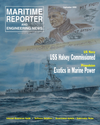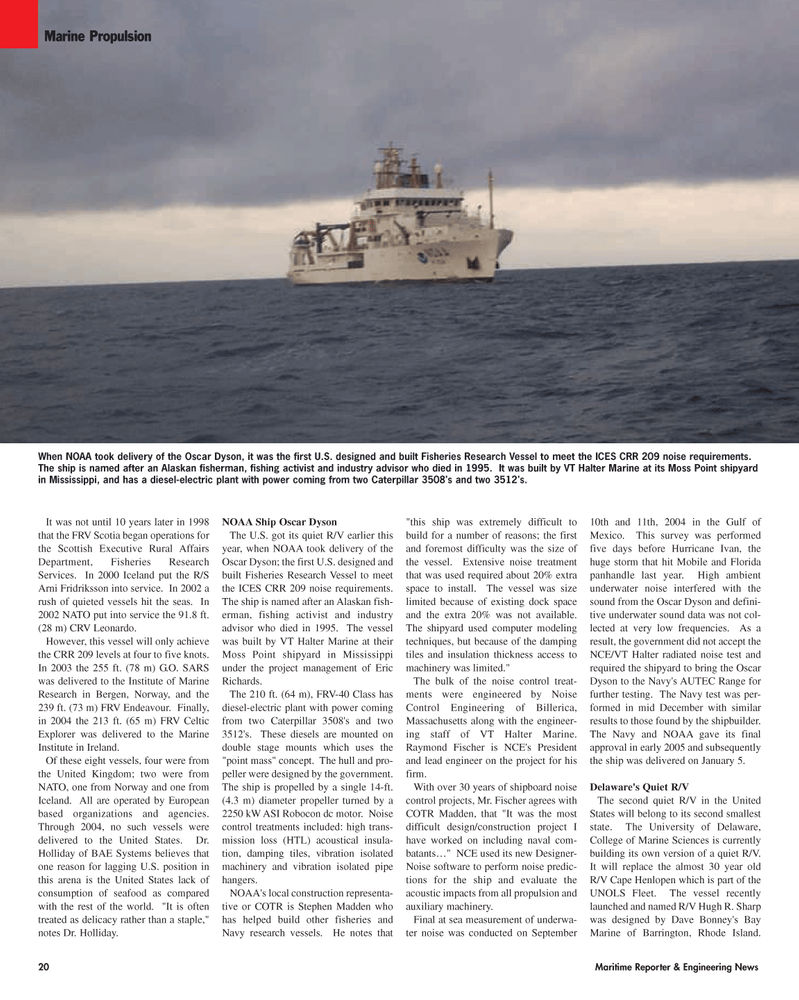
Page 20: of Maritime Reporter Magazine (September 2005)
Marine Propulsion Annual
Read this page in Pdf, Flash or Html5 edition of September 2005 Maritime Reporter Magazine
20 Maritime Reporter & Engineering News
It was not until 10 years later in 1998 that the FRV Scotia began operations for the Scottish Executive Rural Affairs
Department, Fisheries Research
Services. In 2000 Iceland put the R/S
Arni Fridriksson into service. In 2002 a rush of quieted vessels hit the seas. In 2002 NATO put into service the 91.8 ft. (28 m) CRV Leonardo.
However, this vessel will only achieve the CRR 209 levels at four to five knots.
In 2003 the 255 ft. (78 m) G.O. SARS was delivered to the Institute of Marine
Research in Bergen, Norway, and the 239 ft. (73 m) FRV Endeavour. Finally, in 2004 the 213 ft. (65 m) FRV Celtic
Explorer was delivered to the Marine
Institute in Ireland.
Of these eight vessels, four were from the United Kingdom; two were from
NATO, one from Norway and one from
Iceland. All are operated by European based organizations and agencies.
Through 2004, no such vessels were delivered to the United States. Dr.
Holliday of BAE Systems believes that one reason for lagging U.S. position in this arena is the United States lack of consumption of seafood as compared with the rest of the world. "It is often treated as delicacy rather than a staple," notes Dr. Holliday.
NOAA Ship Oscar Dyson
The U.S. got its quiet R/V earlier this year, when NOAA took delivery of the
Oscar Dyson; the first U.S. designed and built Fisheries Research Vessel to meet the ICES CRR 209 noise requirements.
The ship is named after an Alaskan fish- erman, fishing activist and industry advisor who died in 1995. The vessel was built by VT Halter Marine at their
Moss Point shipyard in Mississippi under the project management of Eric
Richards.
The 210 ft. (64 m), FRV-40 Class has diesel-electric plant with power coming from two Caterpillar 3508's and two 3512's. These diesels are mounted on double stage mounts which uses the "point mass" concept. The hull and pro- peller were designed by the government.
The ship is propelled by a single 14-ft. (4.3 m) diameter propeller turned by a 2250 kW ASI Robocon dc motor. Noise control treatments included: high trans- mission loss (HTL) acoustical insula- tion, damping tiles, vibration isolated machinery and vibration isolated pipe hangers.
NOAA's local construction representa- tive or COTR is Stephen Madden who has helped build other fisheries and
Navy research vessels. He notes that "this ship was extremely difficult to build for a number of reasons; the first and foremost difficulty was the size of the vessel. Extensive noise treatment that was used required about 20% extra space to install. The vessel was size limited because of existing dock space and the extra 20% was not available.
The shipyard used computer modeling techniques, but because of the damping tiles and insulation thickness access to machinery was limited."
The bulk of the noise control treat- ments were engineered by Noise
Control Engineering of Billerica,
Massachusetts along with the engineer- ing staff of VT Halter Marine.
Raymond Fischer is NCE's President and lead engineer on the project for his firm.
With over 30 years of shipboard noise control projects, Mr. Fischer agrees with
COTR Madden, that "It was the most difficult design/construction project I have worked on including naval com- batants…" NCE used its new Designer-
Noise software to perform noise predic- tions for the ship and evaluate the acoustic impacts from all propulsion and auxiliary machinery.
Final at sea measurement of underwa- ter noise was conducted on September 10th and 11th, 2004 in the Gulf of
Mexico. This survey was performed five days before Hurricane Ivan, the huge storm that hit Mobile and Florida panhandle last year. High ambient underwater noise interfered with the sound from the Oscar Dyson and defini- tive underwater sound data was not col- lected at very low frequencies. As a result, the government did not accept the
NCE/VT Halter radiated noise test and required the shipyard to bring the Oscar
Dyson to the Navy's AUTEC Range for further testing. The Navy test was per- formed in mid December with similar results to those found by the shipbuilder.
The Navy and NOAA gave its final approval in early 2005 and subsequently the ship was delivered on January 5.
Delaware's Quiet R/V
The second quiet R/V in the United
States will belong to its second smallest state. The University of Delaware,
College of Marine Sciences is currently building its own version of a quiet R/V.
It will replace the almost 30 year old
R/V Cape Henlopen which is part of the
UNOLS Fleet. The vessel recently launched and named R/V Hugh R. Sharp was designed by Dave Bonney's Bay
Marine of Barrington, Rhode Island.
Marine Propulsion
When NOAA took delivery of the Oscar Dyson, it was the first U.S. designed and built Fisheries Research Vessel to meet the ICES CRR 209 noise requirements.
The ship is named after an Alaskan fisherman, fishing activist and industry advisor who died in 1995. It was built by VT Halter Marine at its Moss Point shipyard in Mississippi, and has a diesel-electric plant with power coming from two Caterpillar 3508's and two 3512's.
MR SEPTEMBER 2005 #3 (17-24).qxd 9/1/2005 11:26 AM Page 20

 19
19

 21
21
